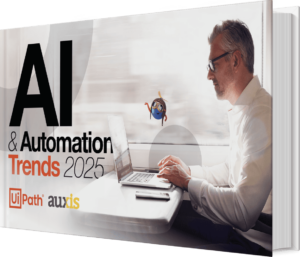Documenting process steps can be an automation pain point, traditionally involving a tedious and time-consuming manual effort that’s prone to human error. However, it no longer needs to be. UiPath’s Task Capture process discovery tool has emerged as a game-changer – accelerating automation development and process improvements with fast, accurate, and intelligent automated business process documentation.
Previously, moving from process recording to automation could drag for weeks. Manually documenting the steps that comprise a task required a business analyst with the right methodology and skillset to spend hours with a willing Process Expert: monitoring steps, asking questions, and meticulously mapping results into a Process Definition Document (PDD).
At a time when accelerating digital transformation is key to success, UiPath Task Capture fast-tracks automation by bridging the documentation gap between Process Experts and Robotic Process Automation (RPA) developers. It works side-by-side with employees to capture in-depth insights about the processes they perform, easily transforming employee knowledge into organizational wisdom for even the most complex workflows.
Task Capture takes minutes to uncover how tasks are completed by monitoring all the actions employees take to perform a process from end-to-end, recording interactions like keystrokes, clicks, and data entry. It also collects smart data concerning process statistics, including execution time, text entries, number of actions, and more.
With an accurate deep dive into the specifics of a process, organizations receive an instant and detailed process map that can be used to create new automations, Standard Operating Procedures (SOPs), and tutorials. Not only does understanding each step make it easier to improve how processes are carried out, but it also helps identify tasks ripe for increasing operational efficiency, reducing errors, and improving employee engagement with automation.
UiPath Task Capture 101: Here’s how it works
Task Capture offers two options for documenting business processes:
- Process capture: Actions are recorded as an employee performs them in real-time. The tool takes screenshots of every mouse click and keystroke, automatically generating a comprehensive workflow diagram with titles and descriptions for each step. Users can view previews of the screenshots and overall number of recorded steps.
- Simple template: Users build the overall process map from scratch and then use the tool to capture the actions that comprise each step.
No matter which option you choose, UiPath Task Capture provides agility and flexibility, enabling users to pause or stop recording at any point – and even restart as needed. Every screenshot can be edited and annotated, and information can be edited or added for every step. You can also specify types of actions to record.
However, keep this in mind: Process Experts need to remain hyper-aware of their on-screen movements when using Task Capture, so the tool doesn’t record unnecessary interactions. Having an experienced RPA provider guide you through a process capture can ensure it is performed with efficiency.
Once process documentation is completed, the tool can present it in Microsoft Word format as a PDD for use throughout your organization.
The information can also be exported as a PDD, JPEG image, or workflow template (.xaml format) to other UiPath platforms that integrate with Task Capture. For instance, developers can use Task Capture documentation as a skeleton for building automations in UiPath Studio, documenting automation ideas in Automation Hub, or creating manual test cases in Test Manager.
To launch UiPath Task Capture as a desktop tool, users can register for a temporary, free community license or activate a stand-alone license. Licenses can also be included as part of other UiPath packages.
8 important ways Task Capture can benefit your business
- Accelerate your RPA journey. No matter which documentation method you choose, all your business process steps are recorded quickly, accurately, and completely – delivering a ready-made template for process optimization and automation that makes it easy to align Process Experts, business analysts, and RPA developers. Documentation is completed without churn or delay and minimal effort from the Process Expert.
- Eliminate tedious manual work. After capturing process steps, the tool automatically generates detailed PDDs and automation prototypes.
- Mitigate security concerns. Data captured by the tool is stored locally on the user’s workstation, maximizing data security.
- Build an effective knowledge base. Task Capture makes it easy to build, keep, and share institutional knowledge by creating a complete library of process docs.
- Drive continuous process improvement. UiPath Task Capture delivers the information you need to identify gaps, inefficiencies, and other process areas that require improvement – whether the goal is automation or overall process excellence. By recording user interactions, it also identifies variations in the way tasks are performed, paving the way for standardization that enhances quality.
- Significantly reduce operational costs. Gartner states that combining hyperautomation and redesigned processes can drop operational costs by 30%.
- Improve efficiency, productivity, and employee satisfaction. Uncovering and automating the repetitive, mundane tasks that consume your staff’s time drive efficiency gains and enable them to focus on more engaging, business-critical activities.
- Increase flexibility and efficiency. Task Capture stands as an important complement to other UiPath innovations, making it a perfect fit for a top-down or bottom-up automation strategy. For instance, while Process Mining discovers entire processes ripe for automation, Task Capture helps organizations understand, document, and analyze how each step in the process works.
UiPath Task Capture sets the stage for scaling automation
In today’s fast-paced business environment, infusing business processes with efficiency, speed, and agility are essential to the future of work. But without a clear understanding of the tasks your employees perform, attempts to drive productivity, cost reduction, and higher-quality outputs through process improvements like automation are likely to fall short.
When applied to processes that are clearly defined, no other technology can match the quick benefits of RPA. But despite Deloitte’s prediction for universal adoption next year, unresolved process exceptions are a key reason that only 35% of organizations have been able to achieve any form of RPA scale.
UiPath Task Capture makes it simpler and faster to document every detail in an end-to-end business process. A fundamental part of the RPA toolchain, it uncovers the rules-based, repetitive tasks that exist within your organization – revealing a wealth of opportunities to accelerate continuous process improvement and scale your automation journey company-wide.




